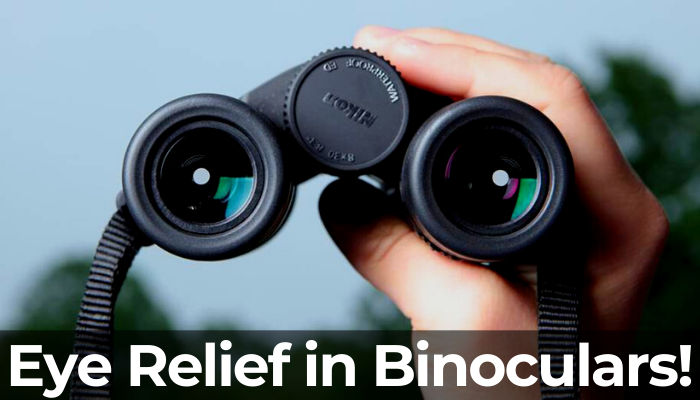This post may contain affiliate links which means I may receive a small commission for purchases made through the links. Learn More
Recently I was watching a youtube video about optics, and I noticed that many people were commenting on what is eye relief in binoculars’’ The speaker was talking about more advanced things but the audience had literally no basic knowledge and seemed to be in trouble.
It was funny, but I felt for those buyers who had a difficult time understanding the eye relief. So, I decided to write this guide to ensure that everyone, especially those who are going to market to buy their first-ever optics, gets in-depth information and avoids falling towards wrong decisions.
Eye relief is the distance between the user’s eyes and the eyepiece or ocular lens. The longer eye relief allows for a more comfortable and relaxed viewing experience. Those people who wear permanent glasses due to weak vision should take Eye relief as their major decision-maker factor.
It is noteworthy that shorter eye relief may cause discomfort or strain on your eyes and the issue worsen if you’ve weak vision. I’ve done complete research to give you in-depth information so stick with us.
Related Article: Why Are Binoculars Important Astronomical Tools?
What is Eye Relief in Binoculars?
Eye relief is the distance between the eyes of the user and the ocular lens or eyepiece. If you don’t know about eyepieces, don’t worry, it is the closest lens to the user when he puts his eye to the barrel of binoculars and it is present in the front of the barrel.
If you’ve used binoculars then you’ll know that there remains the distance between the eyes and the binoculars lens which you see through binoculars. This distance is called eye relief. More distance between the eyes and the eyepiece means that binoculars have better and longer eye relief and vice versa. There are two types of eye relief which are mentioned below;
- Long eye relief
- Short eye relief
Long Eye Relief vs Short Eye Relief
Every binoculars come with different eye relief and it makes binoculars vary from one model to another. Some binoculars have eye relief greater than 16 mm and are said for them that they are decent binoculars with good eye relief.
Binoculars with an eye relief of more than 20 mm are considered to have “long eye relief,” while those with an eye relief of less than 13 mm are considered to have “short eye relief.” I have seen that those binoculars which have eye relief of less than 13 mm fall in the budget category.
The binoculars which come with 16 mm of eye relief are considered perfect for many outdoor activities. However, if a binocular has eye relief less than 13 mm then these binoculars are the most hated things in the world. No one likes to buy them due to their poor eye relief and don’t make binoculars comfortable to use for an extended duration.
| Eye Relief | Description |
| > 20 mm | Long Eye Relief |
| 17 mm to 20 mm | Ideal Eye Relief |
| 16 mm | Decent Eye Relief |
| < 13 mm | Short Eye Relief (Budget) |
Note: Eye relief is always measured and noted in mm.
Relation Between Magnification and Eye Relief
Magnification power and eye relief of binoculars are opposite to each other and you’ll see their value is inversely proportional to each other. The pair with more magnification have eyepieces that are farther apart, which means your eyes have to be closer to the eyepieces to see the whole image.
On the other hand, those binoculars which have less magnification always have eyepieces that are closer together, so your eyes can be a little bit farther away and still see the whole image. It simply means that high-magnification binoculars keep binoculars to themselves and reduce the space between your eyes and the eyepiece.
Also Read: How to Adjust the Diopter on Binoculars?
What is the difference between eye relief and eyepiece?
The eyepiece is the lens located at the back of the binoculars that you look through in order to see the image. It is fixed in place and cannot be changed. In contrast, Eye relief is the distance between the eyepiece and your eye at which you can see the full field of view.
It can be adjusted by using eyecups, which are rubber or plastic cups that surround the eyepieces and help to position your eyes at the correct distance. The eyepieces, also known as ocular lenses, are responsible for focusing the light that enters the binoculars and allowing you to see the image. They are located at the back of the binoculars and are the last lenses in the optical path before the light reaches your eyes.
Note: Eyepiece is either the first lens or last depending on how you hold binoculars in your hands.
What is a good binoculars eye relief – Long or Short?
It is a very interesting question, and I would like to give a detailed answer. When the distance between the eyepiece of the binoculars and the user’s eye is small, individuals who wear glasses may have difficulty viewing through the binoculars. This is because the glasses add an extra layer between the eyes and the eyepieces, increasing the distance between them.
Many outdoor enthusiasts wear glasses, so when they use binoculars, the distance between their eyes and the eyepieces is already increased due to their glasses. If the binoculars have a short eye relief, the distance between the eyes and the eyepieces is further reduced, making it difficult or even impossible for the glasses wearer to see through the binoculars.
On the other hand, binoculars with a long eye relief allow glasses wearers to comfortably use the binoculars, as the distance between the eyepieces and the eyes is sufficient despite the presence of glasses.
Even those who do not wear glasses may benefit from using binoculars with long eye relief, as they tend to be more comfortable and cause less strain on the eyes. In summary, longer eye relief is generally more suitable for both glasses wearers and non-glasses wearers.
Ideally, you should choose binoculars having eye relief above 18 mm. But if you have a tight budget, make sure to have at least 16 mm so that you can enjoy your binoculars with ease. Anything below 13 mm is going to make you feel regretful for sure!
Takeaways: You should always buy binoculars that have longer eye relief so that you can have a perfect viewing experience without getting eye strain.
Eye Relief & Wearing Glasses
Eye relief is especially important for glasses wearers. While individuals who do not wear glasses can still use binoculars with shorter eye relief, those who wear glasses will have difficulty seeing through binoculars with a short eye relief.
To ensure the comfortable use of binoculars with glasses, it is recommended to choose a pair with an eye relief of at least 17 mm. Anything above that will be ideal. Trust me, it will make a big difference in your experience using binoculars with glasses.
Does it matter for non-glasses wearers?
Although non-glass wearers can see through binos even if it has small or short eye relief, they will not find them as comfortable to use. Binoculars with shorter eye relief can cause eye strain and make the user feel discomfort in their eyes.
Therefore, eye relief is important not only for glasses wearers but also for those who do not wear glasses. To ensure a comfortable and strain-free experience using binoculars, it is recommended to choose a pair with long eye relief.
How to determine eye relief?
If you’re more curious now and want to know what is the relief of your binoculars, then below are some tips that will help you determine the eye relief of your binos.
- Check the product specifications
Almost all the binocular brands mention eye relief on the box of the product and some of them polish them on the binoculars body. Do check it there.
- Measure the distance
You can manually measure the distance by yourself. First, hold the binoculars at a comfortable viewing distance and look through them at a distant object. Then, move your eyes slightly away from the eyepieces and measure the distance between your eyes and the eyepieces using a tape measure or a ruler.
Can eye relief be adjusted?
In the past, binoculars used to come with fixed eye relief and the users had the luxury to change their eye relief. But modern binoculars come with adjustable eye cups that can help the user to increase or decrease eye relief depending upon the needs. I highly recommend you choose those binos which have adjustable eyecups so that you can use eye relief according to your own will and needs.
Frequently Asked Questions
15 mm of eye relief is considered decent. But if you choose anything above 15 mm, then the deal will be ideal.
Eye relief is very important, it can make or break your fun. Longer eye relief allows for a more comfortable viewing experience, especially for those with weaker vision or who wear glasses. Shorter eye relief can cause discomfort or strain on the eyes.
Generally, higher magnification binoculars have shorter eye relief, while those with lower magnification have longer eye relief. Magnification and eye relief are opposite to each other.
No, eye relief is the distance between the eyepiece and the user’s eye, while the eyepiece is the fixed lens where the user keeps his eyes to see through the binoculars.
Conclusion
Eye relief is an important factor and can have a massive impact on your viewing experience. Bad eye relief can make your binoculars a nightmare and a good one can make them satisfying tools. I recommend you choose higher relief so that you don’t regret it later. I hope this guide will be a great help to you in making informed decisions.

I’m a passionate outdoor activist who has got special love for optics. The school studies in optical mechanics and the travelling experience has made me an expert in optics like binoculars, scopes, and other devices. Stay connected with us for in-depth knowledge!

